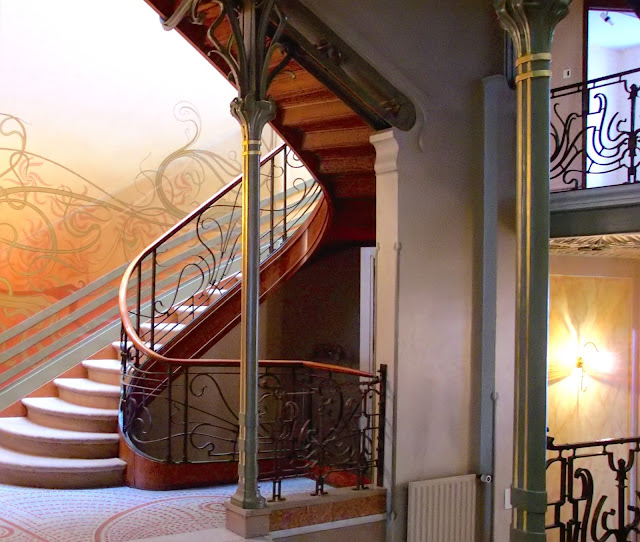Interior of the Hôtel Tassel in Brussels (Credit: by Henry Townsend - Self-photographed, Public Domain, Link)
Art Nouveau, or "New Art" in French, was an international art style that flourished in Europe and the United States from the 1890s to World War I. It was a reaction against the historicism that dominated 19th century art and design, and was characterized by its use of organic lines, asymmetry, and modern materials. Art Nouveau was inspired by nature, with motifs such as plant and flower curves, tendrils, and swirling lines. It was often used in architecture, interior design, jewelry, glass, posters, and illustration.
 |
| Discover Art Nouveau's Soul in an 1894 Home (Fondation Frison Horta; watch the video below) |
Key Features of Art Nouveau Design
Here are some characteristics of Art Nouveau:
- Organic forms: Art Nouveau designs often incorporated flowing, natural forms that resembled plants.
- Linear contours: Linear contours were emphasized over color, which was usually muted greens, browns, yellows, and blues.
- Asymmetry and whiplash lines: These elements created a sense of movement and dynamism.
- Modern materials: Iron, glass, ceramics, and later concrete were used to create unusual forms and open spaces.
Some examples of Art Nouveau include:
- Victor Horta's Tassel House: Built in Brussels in 1893, this house is considered one of the earliest examples of Art Nouveau. Horta designed the architecture, interior, and furnishings, creating a Gesamtkunstwerk, or total art work.
- Winter Garden of the Ursulines (Wintertuin): Built in 1900 for the Ursuline nuns in the village of Onze-Lieve-Vrouw-Waver, this is considered an Art Nouveau gem.
An Art Nouveau "Living Museum" in Belgium (YouTube link)
Gaudí's Unique Interpretation
While Art Nouveau was a widespread movement, Gaudí's work stands out for its extreme originality and complexity. His buildings are often described as organic, with forms resembling plants, animals, and even human figures.
Gaudí's Masterpieces
- Sagrada Familia: This unfinished basilica is Gaudí's most famous work and a UNESCO World Heritage Site. Its unique architectural features, including its towering spires and intricate facades, have made it a global icon.
- Casa Batlló: This remodeled house is a prime example of Gaudí's organic style. Its undulating facade, colorful tiles, and imaginative details create a truly mesmerizing building.
- Casa Milà (La Pedrera): Another iconic building, La Pedrera is characterized by its wave-like facade, sculpted rooftop, and innovative interior design.
 |
Casa Battló: Gaudí's Organic Architectural Wonder |

No comments:
Post a Comment
Note: Only a member of this blog may post a comment.